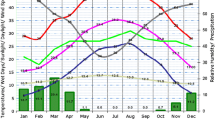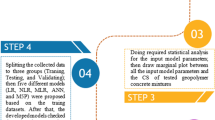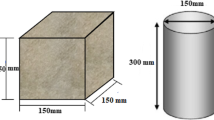Abstract
Concreting in hot weather poses special problems, and the properties of concrete are significantly influenced by mix parameters, construction practices and environmental conditions. In this study, mix design parameters, casting temperature and curing conditions were varied to study the mechanical properties and durability characteristics with the ultimate aim of developing models relating the concrete properties and the experimental parameters. The effect of w/c ratio (0.3 to 0.45), in situ concrete temperature (25 to 45 °C) and curing method (ponding, covering with wet burlap or applying curing compound followed by curing under laboratory or field conditions) was assessed by measuring compressive strength (f′c), split tensile strength (ft), pulse velocity (PV) and depth of water penetration (WP) up to 180 days. Prediction models were developed utilizing quadratic regression models and artificial neural networks (ANNs). The regression models indicated that moist curing, in situ concrete temperature and curing period have a positive impact on the strength parameters and PV, while the former two variables had a negative effect on the WP. The w/c ratio had a significant positive impact on the WP. The concrete properties predicted by ANN models were more accurate than those predicted by regression models. A combined ANN model, developed for predicting strength and PV simultaneously, had a better correlation coefficient compared to ANN models developed for each variable separately. The developed models are expected to assist concrete technologists in the selection of appropriate concrete mixture parameters to obtain concrete with desired properties under hot weather conditions.

(Courtesy: climatemps.com)












Similar content being viewed by others
Abbreviations
- OPC:
-
Ordinary Portland cement
- w/c :
-
Water-to-cement ratio
- ANN:
-
Artificial neural network
- ACI:
-
American Concrete Institute
- ASTM:
-
American Society of Testing Materials
- f′c:
-
Compressive strength of concrete, MPa
- ft:
-
Split tensile strength of concrete, MPa
- PV:
-
Ultrasonic pulse velocity, m/s
- WP:
-
Depth of water penetration, mm
- CGB:
-
Conjugate gradient backpropagation
- RMSE:
-
Root-mean-square error
- MAE:
-
Mean absolute error
- T :
-
In situ concrete temperature, °C
- t :
-
Curing period, days
References
Nasir, M.: Effect of casting temperature and curing regime on mechanical properties and durability of concrete. MS Thesis, Civil and Env. Engg. Deptt., King Fahd University of Petroleum and Minerals, Dhahran (2013)
Alsayed, S.H.; Amjad, M.A.: Effect of curing conditions on strength, porosity, absorptivity and shrinkage of concrete in hot and dry climate. Cem. Concr. Res. 24(7), 1390–1398 (1994)
Jaegerman, C.H.; Raveena, D.; Pundak, B.: Accelerated curing of concrete by solar radiation. In: Proceedings of International Rilem Symposium On Concrete and Reinforced Concrete in Hot Countries, pp. 339–362 (1971)
Shirley, D.E.: Concreting in hot weather. UNESCO Regional Office for Education in Asia and Oceania (1979)
ACI Committee 305.: Guide to Hot Weather Concreting. Farmingt. Hills, Mich. Am. Concr. Institute, p. 23 (2010)
Mouret, M.; Bascoul, A.; Escadeillas, G.: Drops in concrete strength in summer related to the aggregate temperature. Cem. Concr. Res. 27, 345–357 (1997)
Hasanain, G.S.; Khallaf, T.A.; Mahmood, K.: Water evaporation from freshly placed concrete surfaces in hot weather. Cem. Concr. Res. 19(3), 465–475 (1989)
Ortiz, J.; Aguado, A.; Agulló, L.; García, T.: Influence of environmental temperatures on the concrete compressive strength: simulation of hot and cold weather conditions. Cem. Concr. Res. 35, 1970–1979 (2005)
Kayyali, O.A.: Effect of certain mixing and placing practices in hot weather on the strength of concrete. Build. Environ. 19(1), 59–63 (1984)
Alshamsi, M.; Imran, H.D.; Bushlaibi, A.: Drying shrinkage of concrete samples exposed to extreme hot weather. In: Proceedings of the International Conference on Cement Combinations for Durable Concrete, pp. 357–362, (2005)
Al-Negheimish, A.I.; Alhozaimy, A.M.: Impact of extremely hot weather and mixing method on changes in properties of ready mixed concrete during delivery. ACI Mater. J. 105, 438–444 (2008)
Nasir, M.; Al-Amoudi, O.S.B.; Al-Gahtani, H.J.; Maslehuddin, M.: Effect of casting temperature on strength and density of plain and blended cement concretes prepared and cured under hot weather conditions. Constr. Build. Mater. 112, 529–537 (2016)
Klieger, P.: Effect of mixing and curing temperature on concrete strength. ACI J. Proc. 54, 1063–1081 (1958)
Al-Gahtani, H.J.; Abbasi, A.-G.F.; Al-Amoudi, O.S.B.: Concrete mixture design for hot weather: experimental and statistical analyses. Mag. Concr. Res. 50, 95–105 (1998)
Almusallam, A.A.: Effect of environmental conditions on the properties of fresh and hardened concrete. Cem. Concr. Compos. 23, 353–361 (2001)
Abbasi, A.F.; Al-Tayyib, A.J.; Al-Ali, M.B.: Effect of hot weather on strength of reinforced concrete beams. Cem. Concr. Compos. 14(3), 209–221 (1992)
Nasir, M.; Baghabra Al-Amoudi, O.S.; Maslehuddin, M.: Effect of placement temperature and curing method on plastic shrinkage of plain and pozzolanic cement concretes under hot weather. Constr. Build. Mater. 152, 943–953 (2017)
Al-Amoudi, O.S.B.; Maslehuddin, M.: Rasheeduzzafar, permeability of concrete: influential factors. In: 4th International Conference, Deterioration and Repair of Reinforced Concrete in the Arabian Gulf, pp. 717–734, (1993)
Al-Amoudi, O.S.B.; Almusallam, A.A.; Khan, M.M.; Maslehuddin, M.: Effect of hot weather on compressive strength of plain and blended cement mortars. In: Fourth Saudi Engineering Conference, pp. 193–199. King Abdulaziz University, Jeddah, Saudi Arabia (1995)
Ait-Aider, H.; Hannachi, N.E.; Mouret, M.: Importance of W/C ratio on compressive strength of concrete in hot climate conditions. Build. Environ. 42(6), 2461–2465 (2007)
Mannan, M.A.; Basri, H.B.; Zain, M.F.M.; Islam, M.N.: Effect of curing conditions on the properties of OPS-concrete. Build. Environ. 37, 1167–1171 (2002)
Powers, T.C.: A discussion of cement hydration in relation to the curing of concrete. Proc. Highw. Res. Board 27, 178–188 (1947)
Jooss, M.; Reinhardt, H.W.: Permeability and diffusivity of concrete as function of temperature. Cem. Concr. Res. 32, 1497–1504 (2002)
Saricimen, H.; Maslehuddin, M.; Al-Mana, A.I.; Eid, O.: Effect of field and laboratory curing on the durability characteristics of plain and pozzolan concretes. Cem. Concr. Compos. 14(3), 169–177 (1992)
Maslehuddin, M.; Ibrahim, M.; Shameem, M.; Ali, M.R.; Al-Mehthel, M.H.: Effect of curing methods on shrinkage and corrosion resistance of concrete. Constr. Build. Mater. 41, 634–641 (2013)
Wang, J.; Dhir, R.K.; Levitt, M.: Membrane curing of concrete: moisture loss. Cem. Concr. Res. 24(8), 1463–1474 (1994)
Bilgehan, M.; Turgut, P.: Artificial neural network approach to predict compressive strength of concrete through ultrasonic pulse velocity. Res. Nondestruct. Eval. 21(1), 1–17 (2010)
Zhou, Q.; Wang, F.; Zhu, F.: Estimation of compressive strength of hollow concrete masonry prisms using artificial neural networks and adaptive neuro-fuzzy inference systems. Constr. Build. Mater. 125, 417–426 (2016)
Şimşek, B.; İç, Y.T.; Şimşek, E.H.: A RSM-based multi-response optimization application for determining optimal mix proportions of standard ready-mixed concrete. Arab. J. Sci. Eng. 41(4), 1435–1450 (2016)
Al-Gburi, M.; Jonasson, J.-E.; Nilsson, M.: Prediction of restraint in second cast sections of concrete culverts using artificial neural networks. Eur. J. Environ. Civ. Eng. 22(2), 226–245 (2018)
Ahmed, M.; Islam, S.; Nazar, S.; Khan, R.A.: A comparative study of popular concrete mix design methods from qualitative and cost-effective point of view for extreme environment. Arab. J. Sci. Eng. 41(4), 1403–1412 (2016)
Khademi, F.; Akbari, M.; Jamal, S.M.; Nikoo, M.: Multiple linear regression, artificial neural network, and fuzzy logic prediction of 28 days compressive strength of concrete. Front. Struct. Civ. Eng. 11(1), 90–99 (2017)
Hacene, S.M.A.B.; Ghomari, F.; Schoefs, F.; Khelidj, A.: Probabilistic modelling of compressive strength of concrete using response surface methodology and neural networks. Arab. J. Sci. Eng. 39(6), 4451–4460 (2014)
Asteris, P.G.; Kolovos, K.G.; Douvika, M.G.; Roinos, K.: Prediction of self-compacting concrete strength using artificial neural networks. Eur. J. Environ. Civ. Eng. 20(sup1), s102–s122 (2016)
Mashhadban, H.; Kutanaei, S.S.; Sayarinejad, M.A.: Prediction and modeling of mechanical properties in fiber reinforced self-compacting concrete using particle swarm optimization algorithm and artificial neural network. Constr. Build. Mater. 119, 277–287 (2016)
Chithra, S.; Kumar, S.R.R.S.; Chinnaraju, K.; Ashmita, F.A.: A comparative study on the compressive strength prediction models for High Performance Concrete containing nano silica and copper slag using regression analysis and Artificial Neural Networks. Constr. Build. Mater. 114, 528–535 (2016)
Nazari, A.; Hajiallahyari, H.; Rahimi, A.; Khanmohammadi, H.; Amini, M.: Prediction compressive strength of Portland cement-based geopolymers by artificial neural networks. Neural Comput. Appl. 31(2), 733–741 (2019)
Başyigit, C.; Akkurt, I.; Kilincarslan, S.; Beycioglu, A.: Prediction of compressive strength of heavyweight concrete by ANN and FL models. Neural Comput. Appl. 19(4), 507–513 (2010)
Naderpour, H.; Rafiean, A.H.; Fakharian, P.: Compressive strength prediction of environmentally friendly concrete using artificial neural networks. J. Build. Eng. 16, 213–219 (2018)
Khashman, A.; Akpinar, P.: Non-destructive prediction of concrete compressive strength using neural networks. Procedia Comput. Sci. 108, 2358–2362 (2017)
Cheng, C.; Chau, K.; Sun, Y.; Lin, J.: Long-term prediction of discharges in Manwan Reservoir using artificial neural network models. In: International Symposium on Neural Networks (pp. 1040–1045). Springer, Berlin (2005)
Xiao, G.; Ni, M.J.; Chi, Y.; Jin, B.S.; Xiao, R.; Zhong, Z.P.; Huang, Y.J.: Gasification characteristics of MSW and an ANN prediction model. Waste Manag. 29(1), 240–244 (2009)
Abhishek, K.; Kumar, A.; Ranjan, R.; Kumar, S.: A rainfall prediction model using artificial neural network. In: 2012 IEEE Control and System Graduate Research Colloquium (pp. 82–87). IEEE (2012)
Afan, H.A.; El-Shafie, A.; Yaseen, Z.M.; Hameed, M.M.; Mohtar, W.H.M.W.; Hussain, A.: ANN based sediment prediction model utilizing different input scenarios. Water Resour. Manag. 29(4), 1231–1245 (2015)
Kshandelwal, M.; Armaghani, D.J.: Prediction of drillability of rocks with strength properties using a hybrid GA-ANN technique. Geotech. Geol. Eng. 34(2), 605–620 (2016)
Binder, J.J.: On the use of the multivariate regression model in event studies. J. Account. Res. 23(1), 370–383 (1985). https://doi.org/10.2307/2490925
Craven, B.D.; Islam, S.M.: Ordinary Least-Squares Regression. Sage Publications, Thousand Oaks (2011)
Ives, A.R.: For testing the significance of regression coefficients, go ahead and log-transform count data. Methods Ecol. Evol. 6(7), 828–835 (2015)
Yegnanarayana, B.: Artificial Neural Networks. PHI Learning Pvt. Ltd., New Delhi (2009)
He, X.; Xu, S.: Process Neural Networks: Theory and Applications. Springer, Berlin (2010)
Huang, G.-B.; Zhu, Q.-Y.; Siew, C.-K.: Extreme learning machine: a new learning scheme of feedforward neural networks. In: Proceedings 2004 IEEE International Joint Conference on, 2004, Neural Networks, vol. 2, pp. 985–990 (2004)
Dawson, C.W.; Wilby, R.: An artificial neural network approach to rainfall-runoff modelling. Hydrol. Sci. J. 43(1), 47–66 (1998)
Wang, L.; Zeng, Y.; Chen, T.: Back propagation neural network with adaptive differential evolution algorithm for time series forecasting. Expert Syst. Appl. 42(2), 855–863 (2015)
Gazder, U.; Al-Amoudi, O.S.B.; Khan, S.M.S.; Maslehuddin, M.: Predicting compressive strength of blended cement concrete with ANNs. Comput. Concr. 20(6), 627–634 (2017)
Ebrahimzadeh, A.; Ahmadi, M.; Safarnejad, M.: Classification of ECG signals using Hermite functions and MLP neural networks. J. AI Data Min. 4(1), 55–65 (2016)
Jin, R.; Chen, W.; Simpson, T.W.: Comparative studies of metamodelling techniques under multiple modelling criteria. Struct. Multidiscip. Optim. 23(1), 1–13 (2001)
Willmott, C.J.; Matsuura, K.: Advantages of the mean absolute error (MAE) over the root mean square error (RMSE) in assessing average model performance. Clim. Res. 30(1), 79–82 (2005)
Saranya, C.; Manikandan, G.: A study on normalization techniques for privacy preserving data mining. Int. J. Eng. Technol. 5(3), 2701–2704 (2013)
Behnood, A.; Verian, K.P.; Modiri Gharehveran, M.: Evaluation of the splitting tensile strength in plain and steel fiber-reinforced concrete based on the compressive strength. Constr. Build. Mater. 98, 519–529 (2015)
Yousif, S.T.; Abdul-Kareem, O.M.; Ibrahim, K.A.: Artificial neural network model for predicting the compressive strength of concrete using ultrasonic pulse velocity. Muthanna J. Eng. Technol. 5(1), 72–79 (2017)
Acknowledgements
The authors acknowledge the support provided by King Fahd University of Petroleum and Minerals (KFUPM) for this study under KFUPM research grant # RG1101. Imam Abdulrahman Bin Faisal University is also thanked.
Author information
Authors and Affiliations
Corresponding author
Ethics declarations
Conflict of interest
The authors declare that they have no conflict of interest.
Electronic Supplementary Material
Below is the link to the electronic supplementary material.
Rights and permissions
About this article
Cite this article
Nasir, M., Gazder, U., Maslehuddin, M. et al. Prediction of Properties of Concrete Cured Under Hot Weather Using Multivariate Regression and ANN Models. Arab J Sci Eng 45, 4111–4123 (2020). https://doi.org/10.1007/s13369-020-04403-y
Received:
Accepted:
Published:
Issue Date:
DOI: https://doi.org/10.1007/s13369-020-04403-y




